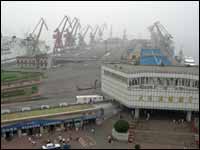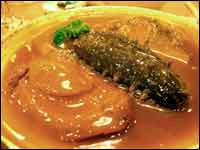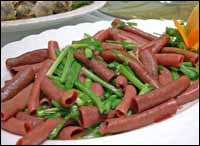Today's Notables
Improving the Quality of Management
September 2005
Hisashi Furuichi
President and C.E.O.
Almost every year, I spend my summer vacation in July with some fellow
avid food connoisseurs on an eating tour. It started with the idea
that in order to go all out and dine in the best places that one
normally cannot go, we would have to contribute to a reserve fund
every month. Our first visit was to a famous steak house in Shinbashi
at about $800 per person. At that cost, we could go overseas and
eat food that was not available in Japan and get a much better value.
Since then, every year we go on a gourmet tour overseas.
Up to now, we visited Seoul, Taipei, and Shanghai. With the help
of some valuable information from local food experts, we've been
able to find the best places to eat and learn about the cuisine.
I especially like visiting markets where food is sold because it
gives you a very good opportunity to enjoy the local food culture
and cuisine. Since we are limited to 3 days and 2 nights, the group
was talking about going back to Shanghai for a second trip but I
happened to meet someone who knew Dalian well so we decided to go
there instead.
Despite the fact that people my age don't have a close association with
Manchuria, when I visited Dalian, I could feel the deep connection
to Japan. There are three states in Manchuria: Liaoning, Jilin,
and Heilongjiang. Dalian is located in the southernmost part of
Liaoning near the Liaoning Peninsula with ocean in three directions
so seafood is abundant. Dailan was established as a city in 1899.
From 1899 to 1904, it was part of the Russian territory; then in
1904 after the Russo-Japanese War to 1945, it was part of Japan.
The architecture is quite different than other areas of China, and
there is a greater mixture of cultures. Relics from times past spot
the landscape and buildings designed by Japanese are not uncommon.
I was surprised at how clean the city was. The streets were relatively
free of garbage and since there were few bicycles and mopeds, it
doesn't fit the stereotypical Chinese city. There are female police
officers which also make it different. They have a height requirement
of 172 cm and some even have come from modeling schools. Those that
are not able to become models, go to the transportation agency for
training to become police officers.
On the subject of food, because of the proximity to the ocean,
seafood is abundant, very fresh and varied. The sizes of many Japanese
favorites such as sea urchin, abalone, and sea slugs are much bigger,
and more delicious. Although dried fish is common, even locals were
eating it raw like sashimi. Flavors have been influenced by the
area's history as a territory so it fits the Japanese palate. Unlike
Shanghai where the sweet flavors are strong, there isn't as much
harmony like the flavors of Japanese cuisine which leaves you feeling
a little like something is missing. Cuisine in Dalian, on the other
hand, seemed like it was a little more unified.
In the northern regions, they did not grow rice historically so there is greater
influence of wheat flour, and thus greater variety.
For example, there were 8 different varieties of delicious gyoza that we ate
at a specialty shop that had different ingredients and shapes.
The hotel served silkworm for breakfast that resembled an egg with a
much richer taste-it was quite good. Fruit is also very abundant
with supermarkets selling the King and Queen of fruit, durian, and
mangosteen. One rare item was a kind of peach that looks like a
pressed, flat persimmon that looked bad but had a strong, delicious flavor.
We are talking about Hong Kong next year and are looking forward
to adventures in eating new and unusual things.
 |
 |
 |
HOME > What’s New > Today's Notables > Details














